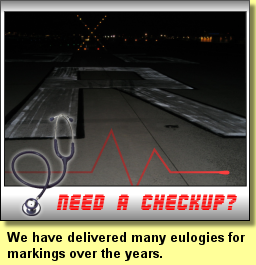 |
 |
Do Your Markings Need a Checkup?By Betsy HudsonWe all hate going to the doctor for a checkup on a regular basis. It is not in our nature to go looking for something if we feel fine. Most of us wait until we are injured or ill to seek the assistance of a professional to determine what is ailing us. You know what they say, "if it isn't broken, don't fix it". Unfortunately, when we neglect to care for ourselves, it can be too late and the damage is done. As strange as it may sound, this is frequently the case with airfield markings. In some cases, throughout their entire life cycle, they never get examined. An annual physical with your doctor gives you a snapshot of your condition. Monitoring reflectivity is somewhat like getting a check-up and is vital to a marking's life.
Without a proper diagnosis, ordering replacement or maintenance can be costly and inefficient.
In order to develop the proper health care plan, we must examine the marking's true level of health with a suitable instrument. Retro-reflectivity is the heartbeat of a marking system; without it, the marking is dead and we are brought in to read it its last rights! 620 millicandelas (mcd/m2/lux) is the recommended value for white markings at speeds of 66-75 mph as stated in a report funded by the Federal Highway Administration1. We encourage our readers to adopt an enhanced version of the P620 paint specification, found in the Appendix of our Airfield Marking Handbook, as it offers suggested or "target" retro-reflectivity readings at installation no matter what bead or paint is used. By monitoring "Brightness" on a regular basis, you are assured that you are getting what you pay for, and most importantly, that visibility is acceptable. A remedy is to adopt performance levels for brightness. Even though there are no requirements regarding initial or maintained values, the U.S. Congress, as part of the Department of Transportation Appropriations Act, directed the Secretary of Transportation to revise the Manual on Uniform Traffic Control Devices to address minimum retro-reflective standards. Implementing a performance specification is valuable; but if it is not enforced, ailing markings can be the outcome. Prescribing specifications as a defense against poor performance is the most economic way to determine the effectiveness of the marking and the ability to maintain it. We encourage agencies to have an assessment method in place based on model experience as the most cost effective means of enhancing situational awareness. Instituting a regular analysis with a retrometer can aid the aviation community in determining when a marking is sick, so hopefully, a little preventative medicine is all we need. Sightline may be just what the doctor ordered: we have a prescription for you. 1Updates to Research on Recommended Minimum Levels for Pavement Marking Retroreflectivity to Meet Driver Night Visibility Needs Report No. FHWA-HRT-07-059 |

 How do you know when a marking is broken? If it were a bone, we would perform an x-ray to diagnose the problem.
How do you know when a marking is aging and exhibits poor visibility unless you look? Sightline measures the condition of your
markings with a retrometer to prescribe the best medicine for your short and long term marking program.
How do you know when a marking is broken? If it were a bone, we would perform an x-ray to diagnose the problem.
How do you know when a marking is aging and exhibits poor visibility unless you look? Sightline measures the condition of your
markings with a retrometer to prescribe the best medicine for your short and long term marking program.